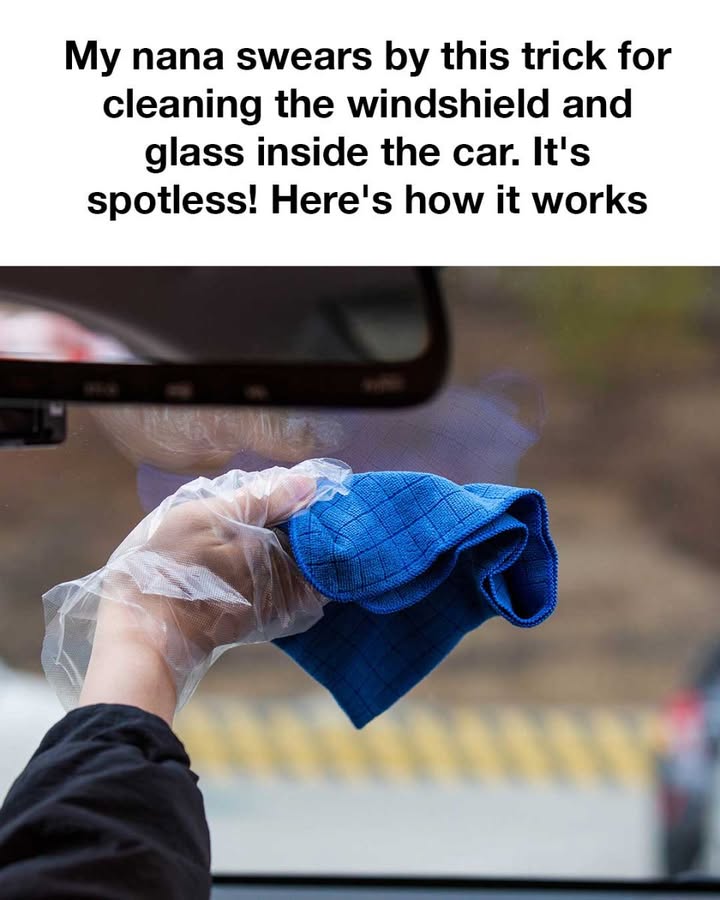My nana has always been a well of wisdom, especially when it comes to clever household tips that just seem to work every single time. One of her most treasured secrets is a surprisingly simple yet incredibly effective method for cleaning car windshields and interior windows. It’s the kind of trick that doesn’t require fancy products or expensive cleaners, just a few basic household items and a little bit of elbow grease.

I’ve seen her do this countless times over the years, and without fail, the glass always ends up looking spotless, streak-free, and crystal clear. Watching her clean with such confidence and seeing the stunning results inspired me to adopt this method for myself, and I haven’t looked back since. What’s great is that this isn’t just about having windows that look good—there’s real value in having a clean windshield and car windows. It’s not just cosmetic; it’s a matter of safety.
A clean windshield provides clear visibility, reduces glare from the sun or oncoming headlights, and helps you stay more alert and focused on the road. Dirty, streaky, or foggy windows can obscure your view and increase the risk of accidents, especially when driving at night or in rainy or snowy weather. Clean glass also gives your car a well-maintained appearance, making it look like you really care about your vehicle. To follow Nana’s method, you don’t need anything complicated. Just gather white vinegar, distilled water, a spray bottle, a soft sponge, and a microfiber cloth. These common items work together to make a powerful cleaning combo.
Start by mixing equal parts of white vinegar and distilled water in a spray bottle, and give it a good shake. Spray the solution generously onto the windshield and the interior glass surfaces. Next, take your soft sponge and gently scrub the glass, paying attention to any stubborn spots or marks. Then, grab your clean microfiber cloth and wipe away the solution using circular motions. This helps prevent streaks and ensures a clear finish. For that extra shine, take a dry section of the microfiber cloth and buff the surface until it gleams. What makes this trick so effective is the science behind it. Vinegar is a natural acid that breaks down oils, grime, and mineral deposits that often cling to glass.
When mixed with distilled water, the solution becomes even more effective because distilled water doesn’t contain any minerals that can leave behind spots or streaks. The microfiber cloth is key too—its fine fibers are designed to trap dirt and moisture without scratching the surface, making it ideal for glass. Compared to many commercial glass cleaners, which can contain harsh chemicals and artificial fragrances, Nana’s method is both eco-friendly and budget-friendly. Those commercial cleaners can work well, but they often leave behind residue or require multiple steps to avoid streaks. Nana’s approach keeps things simple and natural, with fewer steps and better results. If you want to keep your windshield looking spotless for the long haul, it helps to clean it regularly, especially after long trips or bad weather. Avoid parking under trees whenever possible to reduce sap and pollen buildup. Using a sunshade can help protect the interior glass from sun damage and dust. And it’s always a good idea to keep a clean microfiber cloth in your glove compartment so you can wipe away smudges or dirt whenever you need to. Just be sure to avoid a few common mistakes. Don’t use paper towels or rough fabrics, as they can scratch the glass and leave lint behind. Try not to clean the windows in direct sunlight either—the solution may dry too fast and cause streaks. Always make sure your microfiber cloth is clean and dry before starting, and don’t apply too much pressure when scrubbing, as that could damage the glass. People often ask if this method is safe for tinted windows, and the answer is yes—it’s gentle enough that it won’t harm the tint. Some also wonder how often to clean their car windows, and while once a month is a good rule of thumb, more frequent cleaning may be necessary in dusty or polluted environments. If the vinegar smell isn’t your thing, you can swap it for lemon juice, which works similarly and adds a fresh citrus scent. At the end of the day, this method is not only about maintaining your car’s appearance—it’s also about safety, visibility, and giving your vehicle the care it deserves. Thanks to Nana’s timeless trick, achieving sparkling clean windows doesn’t have to be difficult or expensive. It’s a small effort that makes a big difference every time you hit the road.





